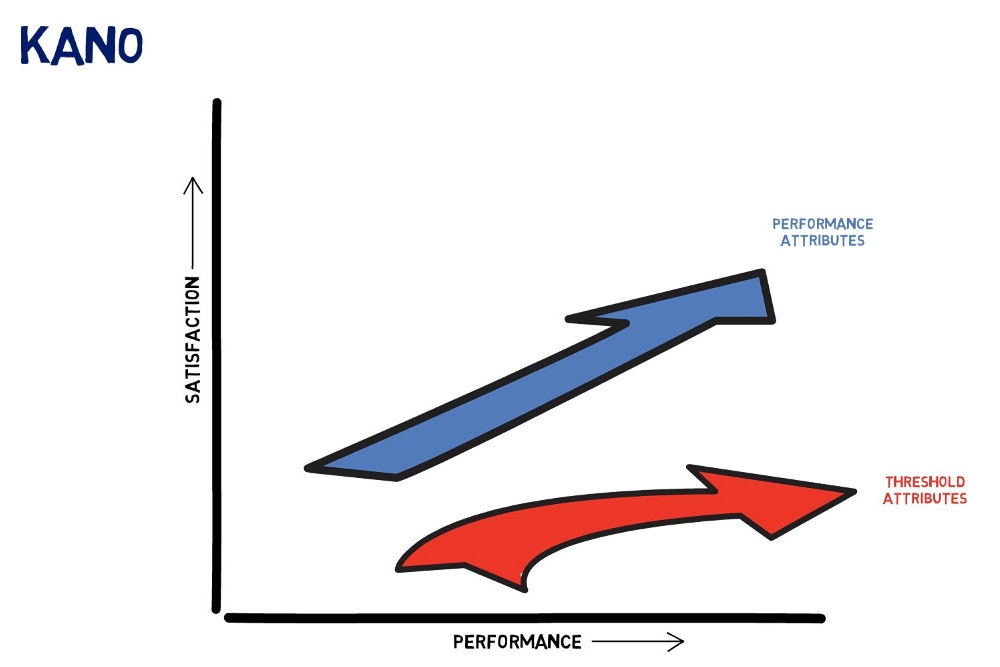The Kano Model (demo)
This is a hidden version of the page on the Kano model. It’s only here for the marketing automation demo. The ‘live’ page can be found here.
The Kano Model is a scientific way to expand on an expression we all know: “sell the sizzle”. It means that we should try to sell the exciting things about our product/service rather than the mundane features that can be found elsewhere. It’s a way to differentiate ourselves from the competition and, thanks to research by Professor Noriaki Kano in the 1980s, there’s scientific backing to show that it works.
Contents
- Threshold Attributes
- Performance Attributes
- Excitement Attributes
- Using the Kano Model is real sales and marketing
Let’s see the model.
The Kano model suggests that every product/service has three types of attributes. These are best illustrated on a chart where product performance rises along the X axis and customer satisfaction rises along the Y axis.
The Kano Model’s Threshold Attributes
The first category of attributes are “threshold attributes”. These are features that every product/service needs to even compete in their market. There are two important characteristics about threshold attributes.
The first is that satisfaction only rises significantly if the characteristics are present. There’s little, if any, scope for improving satisfaction by improving performance. You’ll see that the arrow on the chart makes very little movement up the customer satisfaction axis.
Rory Sutherland (Vice-Chairman, Ogilvy UK) quotes leak-proof milk containers as an example of a threshold attribute. You can’t make one container more leakproof than another. It either is or isn’t. Threshold attributes are almost binary.
Which leads us to the second characteristic of threshold attributes. They’re must-have features. You can’t compete in a market if your product/service doesn’t have the necessary threshold attributes.
You could say that petrol and diesel have a threshold attribute that they run your car. Fuel suppliers try to convince us that their premium fuels run our cars better, but the vast majority of us resolutely stick to the basic version that comes out of their pumps.
The Kano Model’s Performance Attributes
The second category of attributes are “performance attributes”. These can improve customer satisfaction but it’s hard work. There’s a linear relationship between satisfaction and performance. Every increase in satisfaction has to be won by an increase in performance.
You could describe broadband speeds as a performance attribute. Customers are happier when they can download 15 Netflix movies at the same time as they have a Zoom call with Grandma in Australia.
The Kano Model’s Excitement Attributes
But the Kano model is really about the third category of attributes, “excitement attributes”. These are the characteristics that increase satisfaction dramatically even though they may not add much to the performance of the product/service. They’re the irrational characteristics that make people say “I just want it”.
Quoting Rory Sutherland again, he mentions the dampened eject mechanisms that started appearing on cassette players in the 1980s. They made absolutely no difference to the performance of the player, they just looked so cool. Whereas Dolby noise reduction was a performance attribute, the dampened eject mechanism was an excitement attribute.
Cassette decks illustrate another characteristic of the Kano model. Attributes float like a brick. They’re always falling. Dolby noise reduction may have been a performance attribute once but it became a threshold attribute. The dampened eject mechanism fell further, all the way from excitement to threshold attribute.
Using the Kano Model in real sales and marketing
So how do we use the Kano model to improve our sales and marketing?
- Excitement attributes are irrational so be creative in the way you promote them. Be fanciful. Car manufacturers have been doing this for years. Picture the Range Rover that effortlessly scales Snowdon. It plays extremely well with city drivers who never venture outside the M25.
- You might want to employ semi-secret marketing tactics to promote your excitement attributes. Why? Because some purchasers won’t want to admit that’s why they’re buying the product/service. It might be more sensible and appropriate to give the excitement attribute a starring role in your verbal sales pitch rather than your marketing collateral.
- If you can easily change your product/service, you can develop excitement attributes during your sales process. If you ask your potential customer how they’d feel if your product/service had an extra function or characteristic, you can discover what represents an excitement attribute to them.
- If excitement attributes are temporary, we have to capitalise on them while we still have them. People might be excited about a 4K TV now. It’s a near-perfect example of an excitement attribute because there are so few programmes or films that use it. But in a few years, 4K will be a threshold attribute.
- Don’t forget that excitement attributes are only part of the Kano model. If you can make the sale based on them, crack open the champagne. But if you’re selling to a committee or the utterly-rational Financial Director, you’ll also have to promote the hell out of your performance attributes and make sure you offer all the threshold attributes too.



